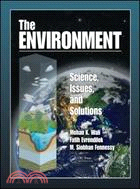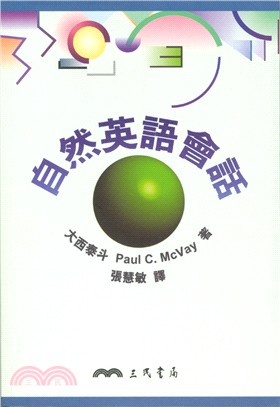定價
:NT$ 6825 元優惠價
:90 折 6143 元
若需訂購本書,請電洽客服 02-25006600[分機130、131]。
相關商品
商品簡介
目次
商品簡介
Students have questions, this book has answers:
What is the structure and function of natural systems?
Where and how do populations and communities live?
How have human impacts altered ecosystems?
How can we lessen impacts and create long term solutions?
Challenging Times Demand Changing Approaches
As the world strives to go green and clean, the discipline of environmental science is poised to take center stage. Its components span many disciplines, subdisciplines, and specialties. Reflecting this, introductory courses are often taught by instructors trained in fields ranging from biology, chemistry, and physics to philosophy and political science. The next generation of environmental scientists, professionals, and decision makers need an understanding of environmental issues that is not only cohesive, but firmly based in science. They need environmental literacy.
Why Another Text on Environmental Science?
Exploiting the fertile ground provided by young and open minds, The Environment: Science, Issues, and Solutions employs a back-to-basics, building-block presentation. The authors’ approach is strongly grounded in science, the scientific method, and environmental evidence. They introduce the principles of ecology, then discuss how the increase in human population, expanded technology use, and unprecedented economic development and growth has altered ecosystems resulting in serious local, regional, and global environmental problems. The book makes a case for seeking long-term solutions for the prevention and mitigation of environmental problems in their interconnected, interrelated, and, thus, interdependent ways.
Fully Integrated Text Rigorously Explores Environmental Issues
The authors’ engaging style piques the interest of students, challenges their critical abilities, and fosters environmental literacy based on a fundamental understanding of the systems of the natural world. The authors emphasize the basics of ecology and use this foundation to build an understanding of major environmental problems and explore methods of mitigating what has been degraded or destroyed. In a logical progression, they provide an understanding of the science, a delineation of the human population and technological growth that has led to environmental issues, and an exploration of solutions to those problems.
What is the structure and function of natural systems?
Where and how do populations and communities live?
How have human impacts altered ecosystems?
How can we lessen impacts and create long term solutions?
Challenging Times Demand Changing Approaches
As the world strives to go green and clean, the discipline of environmental science is poised to take center stage. Its components span many disciplines, subdisciplines, and specialties. Reflecting this, introductory courses are often taught by instructors trained in fields ranging from biology, chemistry, and physics to philosophy and political science. The next generation of environmental scientists, professionals, and decision makers need an understanding of environmental issues that is not only cohesive, but firmly based in science. They need environmental literacy.
Why Another Text on Environmental Science?
Exploiting the fertile ground provided by young and open minds, The Environment: Science, Issues, and Solutions employs a back-to-basics, building-block presentation. The authors’ approach is strongly grounded in science, the scientific method, and environmental evidence. They introduce the principles of ecology, then discuss how the increase in human population, expanded technology use, and unprecedented economic development and growth has altered ecosystems resulting in serious local, regional, and global environmental problems. The book makes a case for seeking long-term solutions for the prevention and mitigation of environmental problems in their interconnected, interrelated, and, thus, interdependent ways.
Fully Integrated Text Rigorously Explores Environmental Issues
The authors’ engaging style piques the interest of students, challenges their critical abilities, and fosters environmental literacy based on a fundamental understanding of the systems of the natural world. The authors emphasize the basics of ecology and use this foundation to build an understanding of major environmental problems and explore methods of mitigating what has been degraded or destroyed. In a logical progression, they provide an understanding of the science, a delineation of the human population and technological growth that has led to environmental issues, and an exploration of solutions to those problems.
目次
Ecosystem Structure and FunctionThe Environment and the Nature of Scientific EnquiryMeaning and Significance of EnvironmentThe Pale Blue DotStories in the NewsAdvent of Global Environmental AwakeningFocus on Environmental Problems SharpensAdvances in Environmental Research and RegulationThe Scientific MethodTypes of Scientific StudiesThe Two Cultures and the EnvironmentThe Urge to Live, Live Well, and Live BetterBiosphere and the Science of EcologyThe BiosphereThe LithosphereThe HydrosphereThe Science of EcologyThe Ecosystem ConceptAtmosphere, Climate, and OrganismsAtmosphereClimate and WeatherGlobal Climate and General CirculationSolar Radiation and LightHeat and Air TemperaturePrecipitation, Humidity, and WindInfluence of TopographyClimate, Weather, and HumansThe Soil EnvironmentSoil DefinedOrigin of SoilsSoil Physical CharacteristicsSoil Chemical RelationsSoil BiotaThe Aquatic EnvironmentCharacteristics of WaterHydrological CycleStreams and RiversFreshwater LakesSaline LakesWetlandsOceans, Seas, and EstuariesBiogeochemical Cycling of MaterialsBiogeochemical CyclesDrivers of Biogeochemical CyclesHydrological or Water CycleGaseous CyclesMineral or Sedimentary CyclesInteractions of Biogeochemical CyclesEnergy Flows and Ecosystem ProductivitySolar Energy—the Driving VariableLaws of ThermodynamicsTerrestrial Primary ProductivityPhotosynthetic PathwaysEcological Controls on Primary ProductivityAquatic Primary ProductivitySecondary ProductivityBioaccumulation through Food WebsPopulation EcologyPopulations—the Central Units in Ecology and EvolutionPopulation GrowthRegulation of Population SizeSpatial Patterns of Population AbundanceLife Histories of OrganismsInterspecific Interactions and Population DynamicsCommunity Ecology and SuccessionEcological CommunitiesCommunity StructureEcological SuccessionChanges in SuccessionControls on SuccessionMechanisms of SuccessionRangeland SuccessionConcept of Climax, Old-Growth, or Mature CommunitiesBiomes—the Major Ecosystems of the WorldIntroductionBiomesTundra and AlpineTaigaTemperate Deciduous ForestGrasslandTemperate Coniferous ForestDry-Mesic ForestTemperate Rain ForestDesertTropical Rain ForestTropical SavannasEcotonesEcoregionsContemporary Environmental IssuesHuman Population GrowthIntroductionForces Driving Human Population GrowthRapid Growth in Numbers Means Greater ConsumptionBiophysical Controls over Population GrowthIncreasing Consumption and Decreasing Natural ResourcesUneven Access to Natural Capital Threatens Global SecurityEnvironmental RefugeesOverall Assessment of Increasing Human NumbersLand Use—AgricultureAgriculture in RetrospectTraditional and Industrialized AgricultureFood Bounty of the United StatesEnergy Input into AgricultureThe Green RevolutionLand Use ConflictsGrowing MonoculturesSustaining Energy SubsidiesBiocides: Use, Persistence, and Health EffectsDisruption of Biogeochemical CyclesSoil ErosionDesertificationAnimal AgricultureChallenges of Food SecurityLand Use—Forest ResourcesForest Ecosystems in PerspectiveGlobal and National Extent of ForestsTypes and Functions of ForestsForest ProductsHarvestingDeforestation and Its Underlying CausesImpacts on Hydrological CycleImpacts on Gaseous and Sedimentary CyclesHabitat Fragmentation and Loss of BiodiversityForest Death: Mortality, Insects, and PathogensForest FiresChallenges for Forest ManagementLand Use—Mining for Mineral and Coal ResourcesIntroductionTypes of MineralsMineral ExplorationExtraction from the GroundMineral ProcessingConsumption Patterns and Environmental ImpactsWaste Production and Disposal—Eastern United States and CanadaWaste Production and Disposal—Western United States and CanadaIndustrial EcologyLegislative MeasuresLand Use—Urbanization and TransportationForces Driving UrbanizationTrends of UrbanizationGrowing Global Urban PopulationLand UseUrban Transportation and ImpactsUrban–Industrial Wastes and Biogeochemical CyclesUrban Climate and Air PollutantsUrban VegetationWater Resources—Quantity and QualityThe Essential Nature of WaterUse and Depletion of Surface and Ground WaterImpounding WaterCompetition for WaterWater Quality—Freshwater and Marine EcosystemsOil Spills in Marine SystemsDecline of FisheriesLegislation on Water IssuesFuel EnergyEnergy as FuelEnergy from BiomassEnergy from Nonrenewable ResourcesFossil Fuel Energy—Retrospect and ProspectEnergy from Renewable ResourcesCurrent Global and National Energy ProfileEnergy PolicyAir Quality and Stratospheric OzoneIntroductionSources of Air PollutantsTypes of Air PollutantsAir Pollutant TransformationsModes of Air Pollutant ActionCriteria Air PollutantsNature of Atmospheric DepositionFactors Affecting Atmospheric DepositionAcidification of Water and SoilsAcidification of Lakes and StreamsAcidification of ForestsAcidification Impacts on AgricultureAtmospheric Pollution and Human HealthAtmospheric Deposition Impacts on MonumentsThe Ozone "Hole" and the Montreal ProtocolThe Greenhouse Effect and Climate ChangeIntroductionGreenhouse Gases and the Greenhouse EffectGeological History and TemperatureCarbon Dioxide and TemperatureEvidence of Carbon Dioxide IncreaseSources and Sinks of CarbonOther Greenhouse GasesEvidence of Global WarmingGeneral Circulation ModelsClimate–Weather UncertaintiesResponse of Biota to Climate ChangeClimate Change and Human HealthRecent National and International ResponsesBiological Diversity Loss and the March of Invasive SpeciesBiological DiversityValues of Safeguarding Biological DiversityBiological InvasionsMajor Factors That Facilitate InvasionsTemporal Attributes of Invasive SpeciesEffects of Invasions on Ecosystem Structure and FunctionHow Do Species Invade So Successfully?Invasions as Agents of Environmental ChangeEconomic Losses from InvasionsGetting Rid of Invasive SpeciesPolicies to Lessen Biodiversity LossSeeking SolutionsEnvironmental Policy and LawIntroductionPolicy-Making and ScienceProcess of Making PolicyEnvironmental PolicyEnvironmental Policy and EcologyEnvironment and Energy: an ExamplePublic versus Private RightsEnvironmental Policy and Law: the United States as an ExampleLegislative Goals versus Implementation ActionsInternational Issues, Laws, and TreatiesEnvironmental Policy InstrumentsEnvironmental JusticeThe Precautionary PrincipleMiles Gained, Miles RemainingEconomic Systems, Growth, and DevelopmentEconomics and Its BeginningEconomic Practice and Its Major PrinciplesResourcesThe ExternalitiesGlobal Poverty and Economic Sector SubsidiesEnvironmental and Resource EconomicsEconomics and EcologySteady-State EconomicsEcological EconomicsGrowth and DevelopmentMarket Economics: GDP and GNPGenuine Progress IndicatorHuman Development IndexThe Concept of Ecological FootprintEnvironmental ManagementPrinciples of Adaptive Ecosystem ManagementEnvironmental Information SystemsEcosystem AnalysesEcosystem Classification SystemsEcosystem Integrity and StabilityAssessment of Environmental Health and RisksManagement of Damaged versus Intact EcosystemsDesign and Management of Natural Protection AreasSustainable Watershed ManagementBest Land Management PracticesRestoration of Disturbed EcosystemsRestoring Degraded SystemsRestoration, Rehabilitation, or…Initiating the Process of RestorationThe Restoration ProtocolGrassland Restoration on Mined LandsForest Restoration on Mined LandsRestoration of WetlandsWetland Conservation EffortsBrownfields, Bioremediation, and PhytoremediationEvaluating SuccessGlobal Imperative of Restoration EconomyConservation of Biological Diversity and Natural ResourcesPrinciples for ConservationBiological Diversity and Ecosystem ServicesExtinction Is a Natural ProcessThe Control of Invasive SpeciesConservation BiologyStrategies for ConservationConservation of Natural ResourcesCase Study: Recycling and Natural ResourcesSustainable DevelopmentApproaches to Achieving SustainabilityThe Concept of Sustainable DevelopmentEcological Controls on Sustainable DevelopmentRevolutionary Thinking in Economics Is NeededCases in Point: Food Production and Renewable EnergyThe Eco-City Concept: Green CitiesEcotourismSustainability Inter AliaEnvironmental Awareness Is Here to StayThe Road AheadReferencesGlossary
主題書展
更多
主題書展
更多書展本週66折
您曾經瀏覽過的商品
購物須知
外文書商品之書封,為出版社提供之樣本。實際出貨商品,以出版社所提供之現有版本為主。部份書籍,因出版社供應狀況特殊,匯率將依實際狀況做調整。
無庫存之商品,在您完成訂單程序之後,將以空運的方式為你下單調貨。為了縮短等待的時間,建議您將外文書與其他商品分開下單,以獲得最快的取貨速度,平均調貨時間為1~2個月。
為了保護您的權益,「三民網路書店」提供會員七日商品鑑賞期(收到商品為起始日)。
若要辦理退貨,請在商品鑑賞期內寄回,且商品必須是全新狀態與完整包裝(商品、附件、發票、隨貨贈品等)否則恕不接受退貨。























